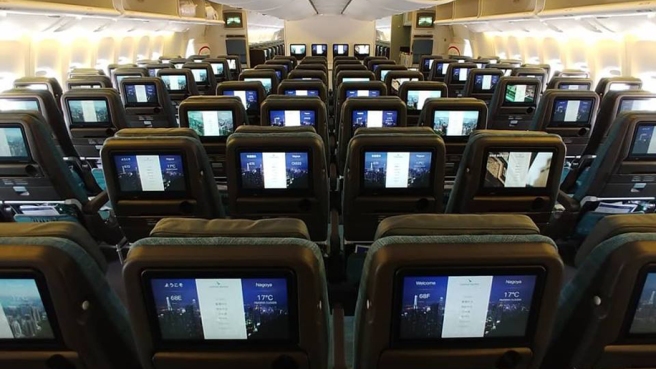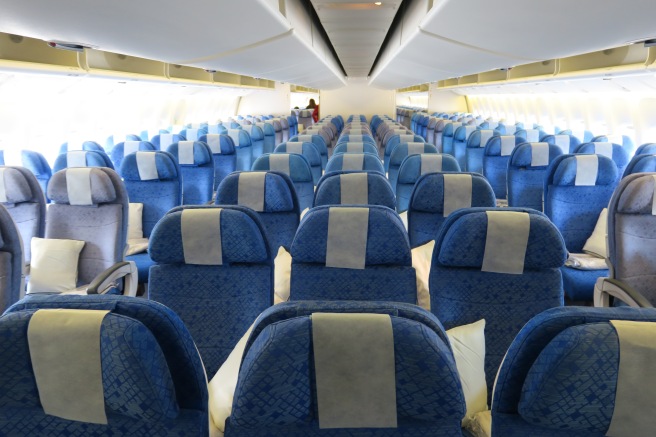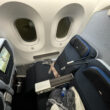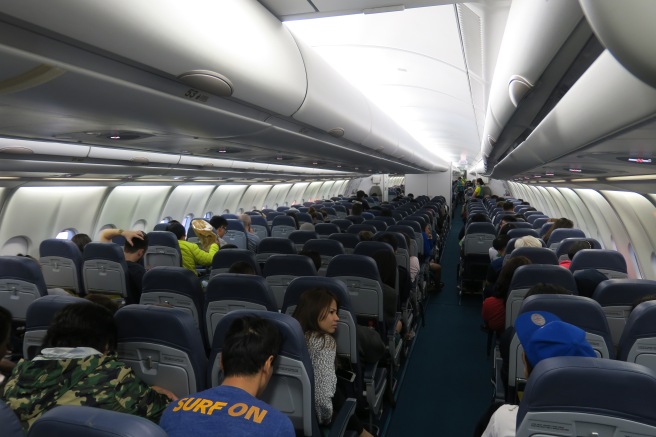A few days ago Cathay Pacific’s first 10-abreast 777 started flying. While 10-abreast economy class on a 777 is never a good thing, Cathay Pacific at least made an attempt to promise a superior hard product to all other 10-abreast products in the market. I haven’t flown the product yet, so I can’t confirm if they’ve followed up on what they’ve said; based on photos alone, I’m not convinced.
 Cathay Pacific Boeing 777 Economy Class (courtesy of Business Traveler)
Cathay Pacific Boeing 777 Economy Class (courtesy of Business Traveler)
Business Traveler has somewhat of a brief review of the seat, while Daniel Chan on Flickr seems to have released more extensive photos (thanks reader Herb).
So, who will get to fly Cathay Pacific’s newest economy product? The first 777 to get Cathay Pacific’s 10-abreast economy class product is B-KPY, a 3-class 777. If you’re booked on a 3-class 777 in economy class, it’s a lottery draw on if you’ll get the plane or not. As of the past week, Osaka Kansai, Mumbai, Nagoya, London, Toronto and Sydney have all seen the new seats. That’s not to say that you’re guaranteed on the old product if you’re booked on a 3-class 777 in economy class.
 Cathay Pacific’s comfortable 9-abreast 777 seats will soon be no more
Cathay Pacific’s comfortable 9-abreast 777 seats will soon be no more
While the old 777s had 268 economy class seats, the new ones have 296 economy class seats, representing a 10% increase in capacity. If you’re booked on a four-class 777 (with first class), you’re safe for now.
How do you know which aircraft you’re going to be seated on? Since there’s only one 10-abreast 777 circulating throughout the fleet arbitrarily as of now, you won’t be able to specifically avoid flying this aircraft if you’re flying a 3-class 777. Simply go on Cathay Pacific’s website and make a dummy booking for your flight business class, and go all the way to seat selection (or pull up the seatmap for your flight otherwise). If your business class cabin goes all the way to row 26, you’re good (on a four-class configuration 777, where all aircraft still have the comfortable old economy seats). If your flight’s business class cabin only goes to row 23, you have a small chance of getting on Cathay Pacific’s 10-abreast configuration.
In terms of longhaul flights, all 777 flights to Australia are vulnerable to the new configuration, as well as (but not limited to) select 777 flights to London, Amsterdam, Johannesburg and Vancouver.
This isn’t much of a concern for now, as Cathay Pacific probably can’t chock these new planes full of people yet (due to the unpredictability of where the sole new 777 will be deployed), so there’ll probably be a few empty seats on your flight. However, as summer holidays approach and the number of retrofitted 777s increases, you’ll have a much higher chance of experiencing a significantly more cramped product.
How cramped is the product specifically?
While the old seat was 18.5″ wide, the new seats are around 17.2″ wide. If you’ve flown a 10-abreast 777 before, these seats won’t be much different in terms of width.
If you’ve flown a 9-abreast 787 (basically any non-Japan Airlines 787) in economy class, the seat width on this 777 will be comparable.
If you’ve flown a 737 in economy class before, this seat will be comparably wide as well.
Ethan’s written about flying 10-abreast 777 economy class before, and while you’d probably want to avoid this configuration on a longhaul flight, it isn’t terrible when flying shorthaul, especially since Cathay Pacific’s improved some aspects of the seat such as storage and the size of the IFE screen.
Bottom Line
A shift to 10-abreast is almost never a welcome change, and it’s even more disappointing that Cathay Pacific is making these switches unpredictable. That said, I have to be fair to them – retrofitting is an inflexible process, and there’s no point announcing an equipment change on a specific flight that people would consequently like to avoid.
I’d love to try this configuration out before the end of the year, and if you’re trying out Cathay Pacific’s 777 10-abreast economy class product in the meantime, I’m curious to hear your thoughts.









